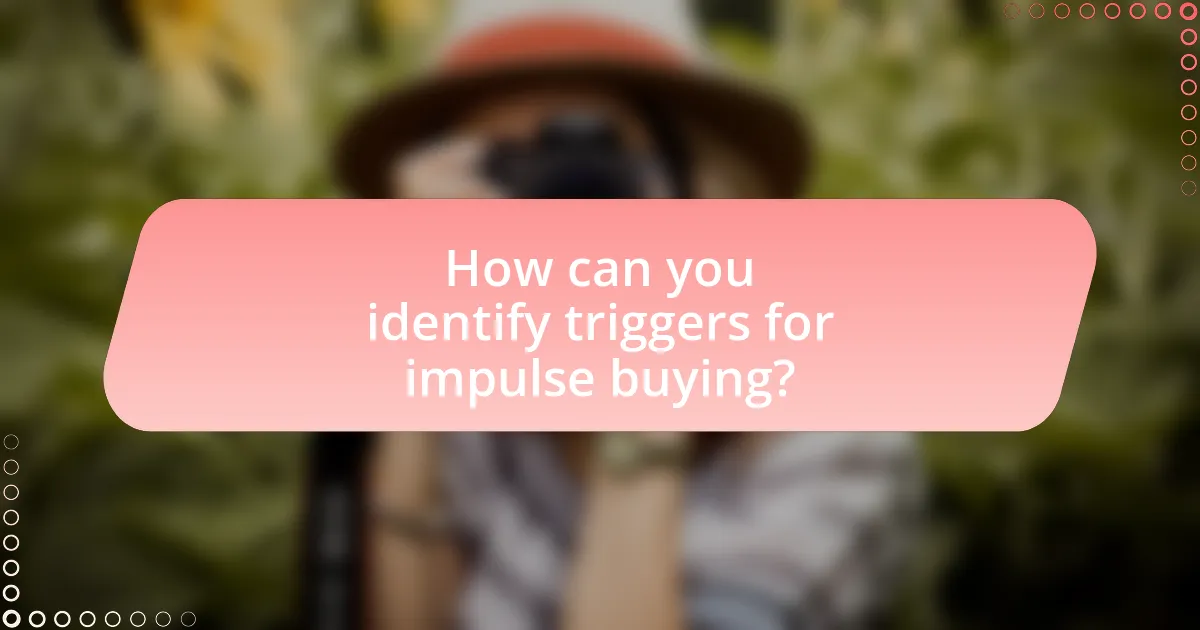The article focuses on the concept of mindful shopping and strategies to avoid impulse buys. It defines mindful shopping as making intentional purchasing decisions based on needs and values, emphasizing the importance of awareness, intentionality, and reflection. Key principles include setting a budget, creating a shopping list, and recognizing emotional and environmental triggers that lead to impulsive behavior. The article also explores the psychological factors influencing consumer behavior, the long-term financial effects of impulse buying, and practical tips for enhancing self-control and accountability in shopping practices. Overall, it aims to promote more thoughtful consumption in today’s consumer culture.

What does it mean to shop mindfully and avoid impulse buys?
Shopping mindfully means making intentional purchasing decisions based on needs and values rather than emotions or external pressures. This approach involves evaluating the necessity of an item, considering its long-term value, and reflecting on personal financial goals before making a purchase. Avoiding impulse buys is a key aspect of mindful shopping, which can be achieved by implementing strategies such as creating a shopping list, setting a budget, and allowing time to think before buying. Research indicates that consumers who practice mindfulness in shopping are less likely to experience buyer’s remorse and more likely to feel satisfied with their purchases, as they align with their personal values and financial objectives.
Why is mindful shopping important in today’s consumer culture?
Mindful shopping is important in today’s consumer culture because it promotes intentional purchasing decisions that reduce waste and enhance personal satisfaction. In an era characterized by overconsumption and environmental concerns, mindful shopping encourages consumers to evaluate their needs versus wants, leading to more sustainable choices. Research indicates that mindful consumers are less likely to engage in impulse buying, which can contribute to financial strain and clutter. A study published in the Journal of Consumer Research found that consumers who practiced mindfulness reported higher levels of satisfaction with their purchases, reinforcing the value of thoughtful consumption in a fast-paced market.
How does consumer psychology influence impulse buying?
Consumer psychology significantly influences impulse buying by affecting emotional responses and decision-making processes. Research indicates that consumers often make spontaneous purchases driven by emotions such as excitement or stress, rather than rational thought. For instance, a study published in the Journal of Consumer Research found that consumers are more likely to engage in impulse buying when they experience positive emotions, as these feelings can create a sense of urgency and a desire for immediate gratification. Additionally, environmental factors like store layout, promotional displays, and sensory stimuli can trigger impulsive behavior by capturing attention and enhancing emotional engagement. This interplay between psychological triggers and situational cues underscores the importance of understanding consumer psychology in the context of impulse buying.
What are the long-term effects of impulse buying on personal finances?
Impulse buying negatively impacts personal finances in the long term by leading to increased debt and reduced savings. Individuals who frequently engage in impulse purchases often accumulate credit card debt, as they may spend beyond their means. According to a study published in the Journal of Consumer Research, impulse buyers are more likely to experience financial stress and lower overall financial well-being due to their spending habits. This behavior can also hinder the ability to save for future goals, such as retirement or emergencies, as funds are diverted to unplanned purchases rather than being allocated to savings accounts.
What are the key principles of mindful shopping?
The key principles of mindful shopping include awareness, intentionality, and reflection. Awareness involves recognizing one’s emotions and triggers that lead to impulsive purchases, allowing shoppers to make conscious decisions. Intentionality emphasizes the importance of having a clear purpose for each purchase, ensuring that items align with personal values and needs. Reflection encourages evaluating past shopping experiences to learn from mistakes and reinforce positive habits. These principles collectively promote a more thoughtful approach to shopping, reducing unnecessary spending and enhancing overall satisfaction with purchases.
How can setting a budget help in shopping mindfully?
Setting a budget helps in shopping mindfully by providing a clear financial framework that limits spending and encourages thoughtful purchasing decisions. When individuals establish a budget, they become more aware of their financial limits, which reduces the likelihood of impulse buys. Research indicates that consumers who adhere to a budget are 30% less likely to make unplanned purchases compared to those who do not budget. This structured approach fosters intentionality in shopping, allowing individuals to prioritize needs over wants and make informed choices that align with their financial goals.
What role does self-awareness play in avoiding impulse purchases?
Self-awareness plays a crucial role in avoiding impulse purchases by enabling individuals to recognize their emotional triggers and motivations for buying. When consumers are self-aware, they can identify feelings such as boredom, stress, or social pressure that often lead to unplanned spending. Research indicates that self-awareness can enhance decision-making processes; for instance, a study published in the Journal of Consumer Research found that individuals who practiced self-reflection were less likely to make impulsive purchases because they could evaluate their needs versus wants more effectively. This understanding allows consumers to pause and reconsider their choices, ultimately leading to more mindful shopping behaviors.

How can you identify triggers for impulse buying?
To identify triggers for impulse buying, individuals should monitor their emotional states and environmental cues that precede unplanned purchases. Research indicates that emotions such as stress, boredom, or excitement can lead to impulsive buying behavior, as highlighted in a study published in the Journal of Consumer Research, which found that emotional states significantly influence purchasing decisions. Additionally, environmental factors like sales promotions, store layout, and social influences can act as triggers. By keeping a journal of shopping experiences and noting feelings and circumstances surrounding purchases, individuals can pinpoint specific triggers that lead to impulse buying.
What common emotional triggers lead to impulse purchases?
Common emotional triggers that lead to impulse purchases include feelings of stress, excitement, and social influence. Stress often drives individuals to seek immediate gratification through shopping as a coping mechanism, while excitement can create a sense of urgency to buy items that enhance positive emotions. Social influence, such as peer pressure or the desire to fit in, can also prompt spontaneous buying decisions. Research indicates that approximately 70% of consumers admit to making impulse purchases due to emotional triggers, highlighting the significant impact of emotions on buying behavior.
How can stress and anxiety influence shopping behavior?
Stress and anxiety can significantly influence shopping behavior by leading individuals to engage in impulsive buying as a coping mechanism. Research indicates that when people experience high levels of stress, they often seek immediate gratification, which can manifest as unplanned purchases. A study published in the Journal of Consumer Research found that individuals under stress are more likely to make impulsive decisions, including shopping, as a way to alleviate their negative emotions. This behavior can result in financial strain and buyer’s remorse, further exacerbating feelings of anxiety.
What social factors contribute to impulse buying?
Social factors that contribute to impulse buying include peer influence, social norms, and marketing strategies. Peer influence can lead individuals to make spontaneous purchases to fit in or impress others, as seen in studies showing that people are more likely to buy items when shopping with friends. Social norms, which dictate acceptable behaviors within a group, can also encourage impulse buying, particularly in environments where spending is normalized. Additionally, marketing strategies, such as limited-time offers and social media advertising, exploit social dynamics by creating a sense of urgency and fear of missing out, further driving impulsive purchases.
How can you recognize environmental triggers in shopping settings?
You can recognize environmental triggers in shopping settings by observing specific stimuli that influence purchasing behavior, such as store layout, lighting, music, and promotional displays. Research indicates that these elements can evoke emotional responses and affect decision-making; for instance, a study published in the Journal of Retailing found that ambient music can significantly increase the time spent in a store and the amount spent by customers. By being aware of these factors, shoppers can identify when their environment is designed to encourage impulse buying, allowing them to make more mindful purchasing decisions.
What impact do store layouts and promotions have on buying decisions?
Store layouts and promotions significantly influence buying decisions by guiding customer movement and creating a sense of urgency. Research indicates that well-designed store layouts can increase sales by up to 20% by strategically placing high-demand items at the back, encouraging customers to traverse the store and encounter additional products. Promotions, such as discounts or limited-time offers, create urgency, prompting customers to make quicker purchasing decisions. A study published in the Journal of Retailing found that promotional signage can increase product sales by 30% when placed at eye level. These factors combined lead to enhanced customer engagement and increased likelihood of impulse purchases.
How can online shopping environments encourage impulse buys?
Online shopping environments can encourage impulse buys through strategic design elements such as limited-time offers, personalized recommendations, and easy navigation. Limited-time offers create a sense of urgency, prompting consumers to make quick purchasing decisions to avoid missing out. Personalized recommendations leverage consumer data to suggest products that align with individual preferences, increasing the likelihood of spontaneous purchases. Additionally, streamlined navigation and visually appealing layouts reduce friction in the shopping experience, making it easier for consumers to add items to their carts without overthinking their choices. Research indicates that these tactics significantly enhance the likelihood of impulse buying, as evidenced by a study published in the Journal of Retailing, which found that urgency and personalization can increase conversion rates by up to 30%.

What strategies can help you shop mindfully?
To shop mindfully, create a shopping list before entering a store and stick to it. This strategy helps prioritize needs over wants, reducing the likelihood of impulse purchases. Research indicates that consumers who use shopping lists spend 20% less than those who do not, as lists encourage focused buying and limit distractions. Additionally, setting a budget before shopping can further enhance mindful spending by establishing clear financial boundaries.
How can creating a shopping list prevent impulse buys?
Creating a shopping list can prevent impulse buys by providing a clear outline of necessary purchases, which helps individuals stay focused and resist distractions. When shoppers have a predetermined list, they are less likely to deviate from their intended purchases, reducing the likelihood of making unplanned buys driven by emotions or marketing tactics. Research indicates that consumers who shop with a list are 28% less likely to make impulse purchases compared to those who do not use one. This structured approach not only streamlines the shopping experience but also encourages mindful spending, ultimately leading to better financial management.
What are the benefits of sticking to a pre-planned shopping list?
Sticking to a pre-planned shopping list helps individuals save money, reduce impulse purchases, and enhance shopping efficiency. Research indicates that consumers who use shopping lists spend 23% less than those who do not, as they are less likely to buy unnecessary items. Additionally, a study published in the Journal of Consumer Research found that having a list can significantly decrease the likelihood of making unplanned purchases, as it provides a clear focus on needed items. This structured approach not only aids in budgeting but also streamlines the shopping process, allowing for quicker trips and less time spent in stores.
How can prioritizing needs over wants aid in mindful shopping?
Prioritizing needs over wants aids in mindful shopping by ensuring that purchases align with essential requirements rather than impulsive desires. This approach encourages consumers to evaluate their spending habits critically, leading to more intentional buying decisions. Research indicates that individuals who focus on needs are less likely to engage in impulse buying, as they are motivated by practicality rather than emotional triggers. For instance, a study published in the Journal of Consumer Research found that consumers who prioritize needs tend to experience greater satisfaction with their purchases, as these align with their long-term goals and values.
What techniques can enhance self-control while shopping?
Techniques that can enhance self-control while shopping include setting a budget, creating a shopping list, and implementing a waiting period before making a purchase. Setting a budget helps individuals limit their spending, thereby reducing the likelihood of impulse buys. Creating a shopping list ensures that only necessary items are purchased, which minimizes distractions from unplanned purchases. Implementing a waiting period, such as 24 hours, allows individuals to evaluate their need for an item, often leading to the realization that the purchase is unnecessary. Research indicates that these strategies can significantly reduce impulsive spending behaviors, as they encourage mindful decision-making and self-regulation.
How does the 24-hour rule help in decision-making?
The 24-hour rule aids in decision-making by allowing individuals to pause and reflect before making a purchase. This delay helps to reduce impulsive decisions driven by emotions, enabling a more rational evaluation of the necessity and value of the item. Research indicates that taking time to consider a purchase can lead to better financial choices and increased satisfaction with decisions, as it encourages individuals to assess their true needs and budget constraints.
What role does accountability play in mindful shopping practices?
Accountability plays a crucial role in mindful shopping practices by encouraging individuals to reflect on their purchasing decisions and align them with their values and goals. When shoppers hold themselves accountable, they are more likely to evaluate the necessity of their purchases, which reduces impulse buying. Research indicates that consumers who set specific goals and share them with others are more likely to stick to their budgets and make intentional purchases, as highlighted in a study published in the Journal of Consumer Research. This accountability can stem from personal commitments or social influences, reinforcing the importance of thoughtful decision-making in shopping behaviors.
What are some practical tips for implementing mindful shopping habits?
To implement mindful shopping habits, individuals should create a shopping list before going to the store and stick to it. This practice helps prioritize needs over wants, reducing the likelihood of impulse purchases. Additionally, setting a budget for each shopping trip can further enhance mindfulness by limiting spending and encouraging thoughtful decision-making. Research indicates that consumers who plan their purchases are less likely to experience buyer’s remorse, as they are more aligned with their financial goals and values.
How can mindfulness practices, like meditation, support better shopping decisions?
Mindfulness practices, such as meditation, can enhance shopping decisions by promoting greater awareness and reducing impulsive behavior. When individuals engage in meditation, they cultivate a state of mindfulness that allows them to pause and reflect before making purchases, leading to more intentional choices. Research indicates that mindfulness can decrease emotional reactivity, which is often a trigger for impulse buying. A study published in the Journal of Consumer Research found that individuals who practiced mindfulness were less likely to make impulsive purchases compared to those who did not. This evidence supports the idea that mindfulness practices can lead to more thoughtful and deliberate shopping experiences.
What are effective ways to reflect on past shopping experiences to improve future behavior?
Effective ways to reflect on past shopping experiences include analyzing purchase decisions, identifying triggers for impulse buys, and evaluating satisfaction with purchases. By reviewing receipts and noting what items were bought, individuals can recognize patterns in their spending habits. Research indicates that 70% of consumers experience buyer’s remorse, highlighting the importance of assessing whether purchases met needs or were made impulsively. Keeping a shopping journal can further aid in tracking emotions and motivations behind purchases, allowing for better decision-making in future shopping endeavors.


